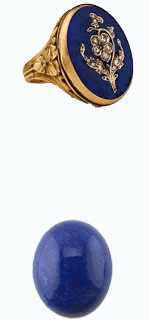| Colors: |
The prices of this gemstone are largely dependent on the beauty and intensity of the color. The most popular is an intense, deep blue, with a minimal amount of spotting or streaks of white. |
| Shapes: |
Lapis Lazuli, being an opaque gemstone, is cut into cabochons and beads, and used mainly in bracelets, necklaces, and pendants. |
| Origin: |
Lapis Lazuli can be found in Chile, the Soviet Union, the United States, but most significantly from the mountains of Afghanistan. |
| Care: |
Lapis Lazuli should always be protected from acidic substances and not be exposed to too much sunlight. |
| Notes: |
The worth of this stone to the world of art is immense, as the ultramarine blue paint of the Old Masters is nothing other than genuine lapis lazuli. Ground up into a powder and stirred up together with binding-agents, the gemstone was used to make radiant blue paints before it became possible to produce the color synthetically. |

